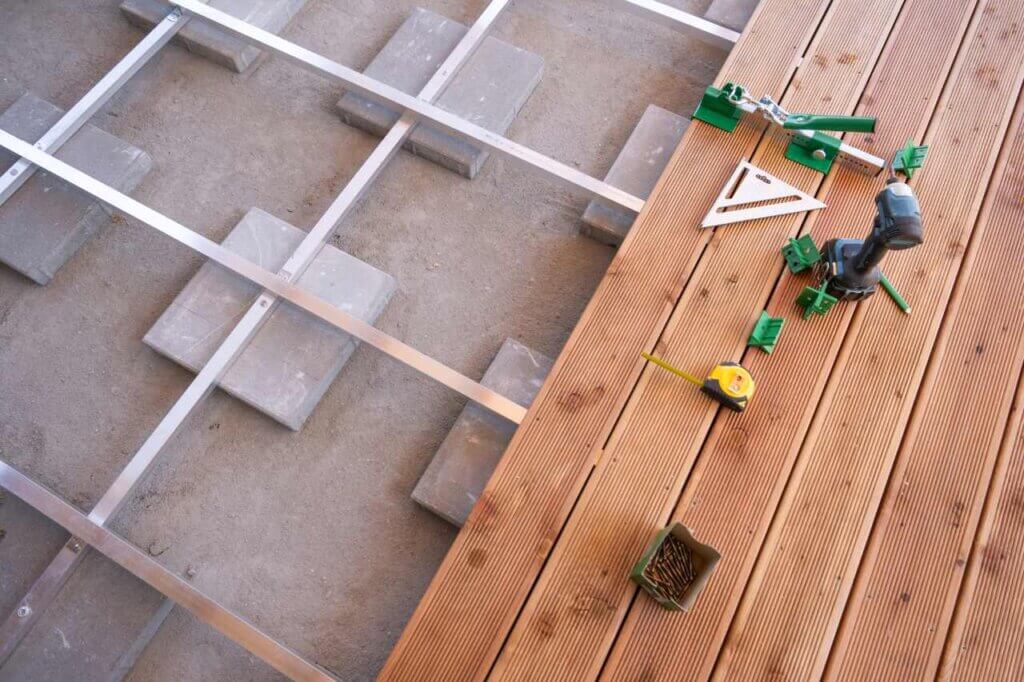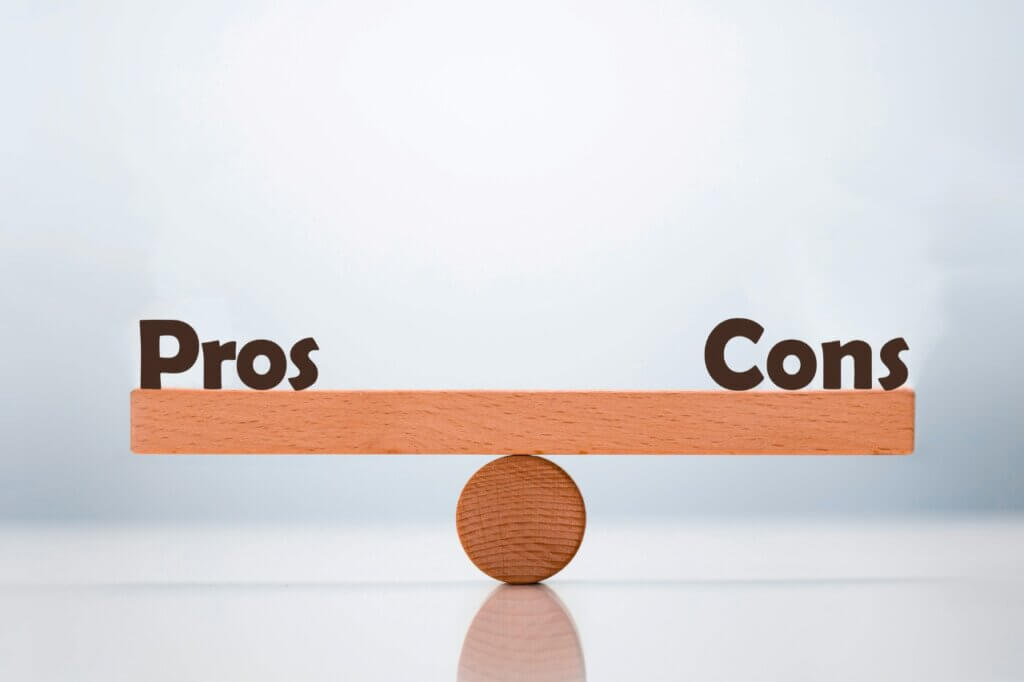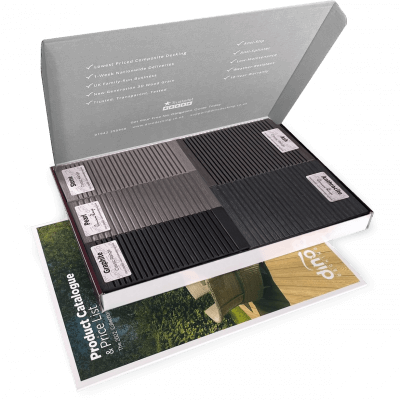5 Composite Decking Lighting Ideas
Our composite decking looks great in any setting, but you can really make your outdoor spaces shine with our decking
Products in Stock
Lowest Prices
Express Delivery
10-Year Warranty
Early April Sale. Up To 15% Off.

To build a high-quality, long-lasting deck, you first need to have a solid foundation. The problem most people face when building a deck is deciding which of the many different types of deck foundation and footing options they should choose.
If that’s the challenge you’re currently facing, you’ve come to the right place. To help you make the right decision for your deck, in this article, we’re going to cover:
But before we go into any more detail on the topics above, let’s first take a look at why choosing the right deck foundation is important.
The foundation of your deck is the key to its overall stability. If the foundation is improperly chosen or installed, it could lead to shifting, settling, or even collapse over time. A well-designed foundation not only supports the deck but also helps maintain its longevity by keeping it secure against environmental factors.
Before selecting a foundation, consider the following key factors that will help you make the best choice for your deck.
The type of soil your deck will be built on plays a vital role in choosing the appropriate foundation. Clay, sandy soil, and rocky ground all affect the foundation differently.
For example, clay soil can shift easily, while sandy soil may not offer enough support without proper reinforcement. So, make sure to test and assess the ground conditions before deciding on a foundation type.
Weather conditions, such as heavy rains, freeze-thaw cycles, or extreme heat, will affect how your foundation holds up over time. Decks in areas with frequent rainfall may require better drainage options, while regions with freezing temperatures will need foundations that can withstand freeze-thaw cycles.
That’s why choosing a foundation that’s built to handle the climate in your area is of key importance.
The size and intended use of your deck also determine which foundation will be the most appropriate. Larger decks or those that will support heavy loads, such as hot tubs, may require stronger foundations while the opposite is true if you’ve looked at different composite decking ideas and have decided to go for a smaller deck that won’t bear too much weight.
Keep these factors in mind as you plan the construction of your deck to ensure the foundation can handle the expected weight.
There are several different types of deck foundations, each with its own set of advantages and challenges. Let’s look at the most common options.
Concrete is one of the most popular and durable materials used for deck foundations. It can be poured in place or precast into blocks and offers long-lasting support. Concrete foundations are ideal for areas with unstable soil or where extra weight-bearing capacity is needed.
Post foundations are another common choice for deck construction. This type of foundation involves securing posts into the ground, typically with concrete, to support the overall structure of the deck. Post foundations work well for decks that need to be elevated or are built on uneven terrain.
Helical piers are a modern foundation option that consists of steel posts with helical blades at the bottom. These posts are screwed into the ground, making them ideal for areas with poor soil conditions or where traditional footing methods are not possible. They are quick to install and provide great stability.
Just like foundations, deck footings are essential for supporting the structure and ensuring stability. There are several types of footings that can be used depending on your project requirements.
Poured concrete footings are a traditional method for supporting decks. Concrete is poured into forms that are placed into the ground to provide a stable base. This type of footing is strong and durable, making it a great choice for decks that need solid support.
Precast concrete footings are pre-manufactured concrete blocks that are placed directly into the ground. They offer quick installation and can be more cost-effective than poured concrete footings. However, they may not offer the same level of customisation as poured concrete.
Diamond pier systems are another innovative footing option. They consist of concrete piers with a series of steel rods that are driven into the ground to create a stable, durable foundation. This system works well for areas with unstable soil or difficult access.
Screw piles, or helical footings, are similar to helical piers in that they are screwed into the ground using a large machine. These footings are excellent for areas where traditional footing methods are not feasible and offer a stable, long-lasting foundation.
Ground spikes are a quick and easy solution for lightweight decks. They are driven directly into the ground and provide basic support for smaller, lower decks. While they’re not suitable for heavy-duty projects, they work well for simple outdoor spaces.

Each foundation and footing type comes with its own set of advantages and disadvantages. Let’s break down the pros and cons of the most popular options.
Choosing the right foundation for your deck requires assessing several factors that are specific to your project, including:
Consider the size of your deck, the weight it needs to support, and the type of soil and climate you’re working with. Once you’ve identified your requirements, you’ll be in a better position to choose the most appropriate foundation.
Make sure to check local building codes and regulations before beginning your project. Some areas have strict guidelines regarding deck construction, including foundation and footing requirements.
If you’re unsure about which foundation and footing options are best for your deck, consulting with a professional builder or contractor can help ensure your project is set up for success.
Choosing the right foundation and footing for your deck is a critical part of ensuring it will remain stable and last for many years to come. By understanding your specific needs and considering the various foundation options, you’ll be able to make an informed decision that will lead to a solid, long-lasting deck.
And once you have a solid foundation set in place, next up, you need to start thinking about the structure and materials for your deck. We highly recommend using composite materials, as they’re not only modern, durable, and low-maintenance, but they are also generally easier to install. Just take a look at our composite decking installation guide and you’ll see for yourself.

Our sample pack contains a sample piece of each colour currently available. Order your free sample pack today to compare the colours and get a true feeling of the Dino Decking range!
Our composite decking looks great in any setting, but you can really make your outdoor spaces shine with our decking
If the idea of having rats under your decking makes you shiver, don’t worry. We’ll let you know the signs
Business hours
Monday: 09:00 – 17:30
Tuesday: 09:00 – 17:30
Wednesday: 09:00 – 17:30
Thursday: 09:00 – 17:30
Friday: 09:00 – 17:30
Saturday: Closed
Sunday: Closed
Contact us
01942 355968
support@dino.co.uk
Collection Address: Unit 1 Wetheral Close Hindley Ind Estate Wigan Greater Manchester North West WN2 4HS
Pages
Products
Testing
Copyright 2025 Dino Decking Ltd All Rights Reserved.
VAT Number: GB296097848.
Company Number: 10837233.